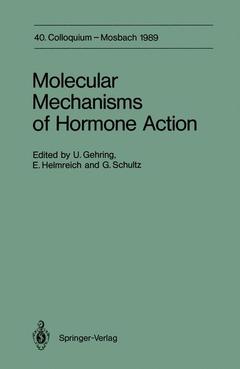Description
Molecular Mechanisms of Hormone Action, Softcover reprint of the original 1st ed. 1989
40. Colloquium, 6.-8. April 1989
Coll. Colloquium der Gesellschaft für Biologische Chemie in Mosbach Baden, Vol. 40
Coordinators: Gehring Ulrich, Helmreich Ernst J.M., Schultz Günter
Language: French
Subjects for Molecular Mechanisms of Hormone Action:
Publication date: 12-2011
Support: Print on demand
Support: Print on demand
Description
/li>Contents
/li>
Recent years have seen tremendous progress in the field of hormone action and consequent signal transduction. The 40th Colloquium Mosbach was devoted to the discussion of results concerning the molecular process of hormone action, especially the processes following hormone binding to the corresponding receptors. Structural and functional aspects of steroid hormone receptors as well as ion-channel-coupled and enzyme-linked receptors were treated in detail. Particular interest focussed on the latest results concerning transcriptional control, protein phosphorylation, the role of G-Proteins, oncogene proteins, involvement of phospholipases and the regulation of ion channels.
1.- Mode of Action of Steroid Hormones: A Historical Review.- Interaction of Steroid Hormone Receptors with DNA.- Clustered Arrangement and Interaction of Steroid Hormone Receptors with Other Transcription Factors.- Chromatin Template Remodeling and Steroid Receptor Transactivation of MMTV.- Hormone-Dependent Transcriptional Activation by Thyroid Hormone Receptors: Functional Homology with Steroid Hormone Receptors.- Subunit Structure of the Glucocorticoid Receptor.- Modulation of Glucocorticoid Hormone Action by Oncogenes and Peptide Hormones.- Studies on the Regulation of Glycogen and Lipid Metabolism by Insulin and Growth Factors: The Involvement of Receptor Tyrosine Kinase Activation and Casein Kinase II.- 2.- Genes Coding for G Proteins in Mammalian and Yeast Cells.- The ras Oncogene Protein.- Molecular Mechanisms of G-Protein Activation.- Interaction of Transducin with Retinal cGMP Phosphodiesterase.- Phosphonositide Metabolism and Visual Signal Transduction.- Hormonal Regulation of Phospholipases.- 3.- Regulation of Ion Channels.- The Structure of the Skeletal and Nonskeletal Muscle Calcium Channel.- Involvement of Pertussis Toxin-Sensitive G-Proteins in the Modulation of Voltage-Dependent Ca2+ Channels by Extracellular Signals.- Multiple Roles of G Proteins in Coupling of Receptors to Ionic Channels and Other Effectors.- The Guanylate Cyclase Family.- Mechanisms for Hormonal Regulation of the Different Isoforms of Guanylate Cyclase.- Catecholamine Receptors: Structure, Function, and Regulation.
© 2024 LAVOISIER S.A.S.




